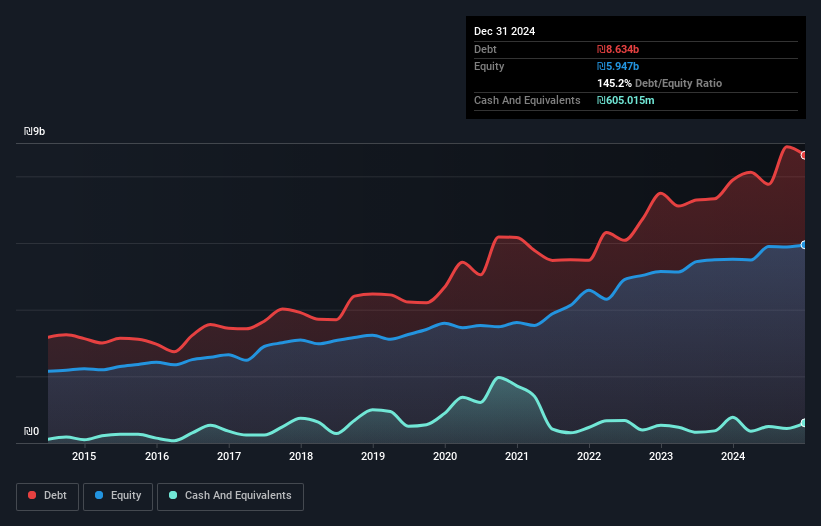Warren Buffett famously said, 'Volatility is far from synonymous with risk.' It's only natural to consider a company's balance sheet when you examine how risky it is, since debt is often involved when a business collapses. As with many other companies Gav-Yam Lands Corp. Ltd (TLV:GVYM) makes use of debt. But should shareholders be worried about its use of debt?
Why Does Debt Bring Risk?
Debt is a tool to help businesses grow, but if a business is incapable of paying off its lenders, then it exists at their mercy. If things get really bad, the lenders can take control of the business. However, a more frequent (but still costly) occurrence is where a company must issue shares at bargain-basement prices, permanently diluting shareholders, just to shore up its balance sheet. Having said that, the most common situation is where a company manages its debt reasonably well - and to its own advantage. The first step when considering a company's debt levels is to consider its cash and debt together.
What Is Gav-Yam Lands's Net Debt?
You can click the graphic below for the historical numbers, but it shows that as of December 2024 Gav-Yam Lands had ₪8.63b of debt, an increase on ₪7.89b, over one year. On the flip side, it has ₪605.0m in cash leading to net debt of about ₪8.03b.

How Strong Is Gav-Yam Lands' Balance Sheet?
The latest balance sheet data shows that Gav-Yam Lands had liabilities of ₪2.34b due within a year, and liabilities of ₪8.64b falling due after that. Offsetting these obligations, it had cash of ₪605.0m as well as receivables valued at ₪80.8m due within 12 months. So its liabilities total ₪10.3b more than the combination of its cash and short-term receivables.
This deficit casts a shadow over the ₪6.67b company, like a colossus towering over mere mortals. So we definitely think shareholders need to watch this one closely. After all, Gav-Yam Lands would likely require a major re-capitalisation if it had to pay its creditors today.
Check out our latest analysis for Gav-Yam Lands
We use two main ratios to inform us about debt levels relative to earnings. The first is net debt divided by earnings before interest, tax, depreciation, and amortization (EBITDA), while the second is how many times its earnings before interest and tax (EBIT) covers its interest expense (or its interest cover, for short). This way, we consider both the absolute quantum of the debt, as well as the interest rates paid on it.
Strangely Gav-Yam Lands has a sky high EBITDA ratio of 12.3, implying high debt, but a strong interest coverage of 12.0. This means that unless the company has access to very cheap debt, that interest expense will likely grow in the future. We saw Gav-Yam Lands grow its EBIT by 4.9% in the last twelve months. That's far from incredible but it is a good thing, when it comes to paying off debt. When analysing debt levels, the balance sheet is the obvious place to start. But you can't view debt in total isolation; since Gav-Yam Lands will need earnings to service that debt. So if you're keen to discover more about its earnings, it might be worth checking out this graph of its long term earnings trend .
Finally, a company can only pay off debt with cold hard cash, not accounting profits. So the logical step is to look at the proportion of that EBIT that is matched by actual free cash flow. During the last three years, Gav-Yam Lands generated free cash flow amounting to a very robust 84% of its EBIT, more than we'd expect. That puts it in a very strong position to pay down debt.
Our View
While Gav-Yam Lands's net debt to EBITDA has us nervous. For example, its conversion of EBIT to free cash flow and interest cover give us some confidence in its ability to manage its debt. Taking the abovementioned factors together we do think Gav-Yam Lands's debt poses some risks to the business. While that debt can boost returns, we think the company has enough leverage now. When analysing debt levels, the balance sheet is the obvious place to start. However, not all investment risk resides within the balance sheet - far from it. These risks can be hard to spot. Every company has them, and we've spotted 3 warning signs for Gav-Yam Lands (of which 1 is a bit unpleasant!) you should know about.
At the end of the day, it's often better to focus on companies that are free from net debt. You can access our special list of such companies (all with a track record of profit growth). It's free.
New: Manage All Your Stock Portfolios in One Place
We've created the ultimate portfolio companion for stock investors, and it's free.
• Connect an unlimited number of Portfolios and see your total in one currency
• Be alerted to new Warning Signs or Risks via email or mobile
• Track the Fair Value of your stocks
Have feedback on this article? Concerned about the content? Get in touch with us directly. Alternatively, email editorial-team (at) simplywallst.com.
This article by Simply Wall St is general in nature. We provide commentary based on historical data and analyst forecasts only using an unbiased methodology and our articles are not intended to be financial advice. It does not constitute a recommendation to buy or sell any stock, and does not take account of your objectives, or your financial situation. We aim to bring you long-term focused analysis driven by fundamental data. Note that our analysis may not factor in the latest price-sensitive company announcements or qualitative material. Simply Wall St has no position in any stocks mentioned.
About TASE:GVYM
Average dividend payer with slight risk.
Market Insights
Community Narratives



